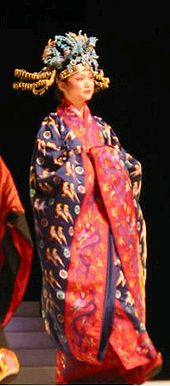
Diyi
Encyclopedia

Ming Dynasty
The Ming Dynasty, also Empire of the Great Ming, was the ruling dynasty of China from 1368 to 1644, following the collapse of the Mongol-led Yuan Dynasty. The Ming, "one of the greatest eras of orderly government and social stability in human history", was the last dynasty in China ruled by ethnic...
. It is a formal wear meant only for ceremonial purposes. It is a form of shenyi
Shenyi
Shenyi is the traditional Chinese attire for men which advocated in Zhu Zi's Common Rites《朱子家禮》. The Shenyi Center of Chinese Medicine is named after it. It is a form of formal wear in the Ming Dynasty. It directly descended from the shenyi worn in earlier dynasties, like Han Dynasty...
, and is embroidered with long-tail pheasants (翟, Di) and circular flowers (小輪花). It is worn with phoenix crown
Phoenix crown
A Phoenix crown is a Chinese traditional headgear for women. It was worn by noblewomen in the Ming Dynasty on ceremonies or official occasions. It is also the traditional headgear for brides. It is adorned with gold dragons, phoenixes made with kingfisher feathers, beaded pheasants, pearls and...
(without the dangling string of pearls by the sides). Diyi has been worn by empresses and other royal noblewomen (differs according to different dynasties) since the Zhou Dynasty
Zhou Dynasty
The Zhou Dynasty was a Chinese dynasty that followed the Shang Dynasty and preceded the Qin Dynasty. Although the Zhou Dynasty lasted longer than any other dynasty in Chinese history, the actual political and military control of China by the Ji family lasted only until 771 BC, a period known as...
under various names like huiyi (褘衣) in Zhou
Zhou Dynasty
The Zhou Dynasty was a Chinese dynasty that followed the Shang Dynasty and preceded the Qin Dynasty. Although the Zhou Dynasty lasted longer than any other dynasty in Chinese history, the actual political and military control of China by the Ji family lasted only until 771 BC, a period known as...
and Song Dynasty
Song Dynasty
The Song Dynasty was a ruling dynasty in China between 960 and 1279; it succeeded the Five Dynasties and Ten Kingdoms Period, and was followed by the Yuan Dynasty. It was the first government in world history to issue banknotes or paper money, and the first Chinese government to establish a...
, and miaofu (庙服) in Han Dynasty
Han Dynasty
The Han Dynasty was the second imperial dynasty of China, preceded by the Qin Dynasty and succeeded by the Three Kingdoms . It was founded by the rebel leader Liu Bang, known posthumously as Emperor Gaozu of Han. It was briefly interrupted by the Xin Dynasty of the former regent Wang Mang...
.
Korean Version
2 variations of the diyi had been developed in Korea during the Joseon DynastyJoseon Dynasty
Joseon , was a Korean state founded by Taejo Yi Seong-gye that lasted for approximately five centuries. It was founded in the aftermath of the overthrow of the Goryeo at what is today the city of Kaesong. Early on, Korea was retitled and the capital was relocated to modern-day Seoul...
, & later in the Korean Empire
Korean Empire
The Greater Korean Empire was an empire of Korea that succeeded the Joseon Dynasty.In October 1897, Emperor Gojong proclaimed the new entity at Gyeongungung Palace and oversaw the partially successful modernization of the military, economy, land system, education system, and various industries...
. The developments were as follows:
- During the Joseon Dynasty, the diyi was known as "Chijeok-ui" (雉翟衣 치적의), and is characterized as a predominant red outfit with a similarity to the wonsam.
- During the Korean Empire, the chijeok-ui was later changed into the (original) blue with red trim similar to its Chinese model.
Diyi were worn by:
- Princesses Consort on their marriage to the Crown Prince and on major ceremonies (大禮服 대례복 daeryebok).
- Queens Consort on their coronation ceremony and on major ceremonies (大禮服 대례복 daeryebok).
- The King's subsequent Queens Consort on their marriage to the King.

